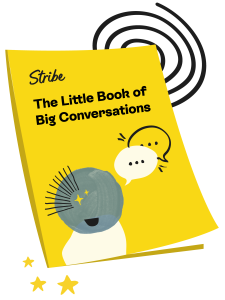7 employee engagement metrics to track that prove impact
Go deeper than surface-level satisfaction scores. Employee engagement metrics to track if you want your engagement efforts to get results.
Read MoreWhat is employee voice and why should you be thinking about it?
Today’s top-performing businesses all have the same thing in common, their employees feel able to talk about anything – from the big things to the little things.
Talking is hard. And great conversations – the ones that really make a difference, get into the details, and get everything out in the open – are elusive. Especially in our busy work life. We shouldn’t have any workplace in the world where we feel that we can’t put our hands up and talk about exactly what we need to.
Talking about anything and everything is a positive thing, particularly in the workplace. Change comes when we speak up and encourage colleagues to do the same which is why employee voice is so important.
A must have for HR leaders. The Little Book of Big Conversations is one of Stribe’s most downloaded resources. It’ll help you strengthen your employees’ voices and create a culture of talking in your team. 👇

American author and management expert Ken Blanchard once famously said “None of us is as smart as all of us” – and we like to think that wonderfully sums up how the impact of collective employee voice can lead to organisational success.
Having a voice at work can make a fundamental difference to how employees experience their work – improving job satisfaction, sense of belonging, creativity, trust in leadership and better decision-making.
Employee voice is a powerful tool, and we’re here to show you that by putting practices in place to encourage your team to be heard and express themselves – you’ll all reap the benefits.

Employee voice is all about giving employees a chance to be heard and share their thoughts, worries, and suggestions.
There are all sorts of ways employees can get their voice heard, from casual channels such as internal communications tools, email, employee surveys and casual conversations to more formal ways such as employee meetings, union negotiations, and performance reviews.
The most important thing is that employees have opportunities to express their views without fear of consequence, and for employers to actively listen and consider what their employees are saying.
From pulse surveys to employee representation groups, these are among the most effective examples of employee voice tools that you can use in your workplace.
Send regular pulse surveys to understand how your employees are feeling. The great thing about these surveys is that they’re anonymous, so employees will feel free to share their true thoughts and opinions.
This might come in the form of an anonymous online messenger, email address, or physical box in your office. You may also wish to use purpose-built employee voice software such as Stribe.
Creating a buddy system can be a great way to encourage employees to support one another, share ideas, and promote a sense of connectedness within a team or across departments.
They’re informal, which also encourages employees to open up more than during more structured/formal discussions.
These groups provide a platform for employees to voice their opinions and bring about change within the workplace in a slightly more formal setting.
They can take the form of works councils, employee forums, or unions.
Group meetings and discussions give employees an opportunity to share their thoughts and opinions with senior management in a collaborative setting.
These meetings create a feeling of open communication and encourage employees to share their ideas with each other, allowing for a diverse range of perspectives to be heard.
They might come in the form of 121s, casual team meetings or larger all-company town halls. If you’re a dispersed or fully remote team you can even do these via Teams or Slack.
Internal communications channels, such as your internal newsletters, emails, or intranet sites, provide employees with a platform to voice their opinions and ideas to a wider audience within the company.
Just be sure to thoroughly introduce employees to the purpose of each channel when they join your team to ensure discussions remain productive.

It allows for that open communication which we’ve never had before.
Employee voice is key to building trust, fostering collaboration, and creating happy and productive teams.
Organisations that listen and act upon the suggestions of their employees often see improvements in productivity and overall business performance.
How?
When employees feel heard they have a stronger sense of commitment and are more likely to stay with their company because they feel that their opinions and ideas are valued.
Employees also provide a diverse range of perspectives, when companies harness the power of employee voice this can lead to better decision-making and more innovative solutions – helping them to outperform their competitors.
When employees feel heard and valued, and are given the opportunity to talk about their opinions, feelings, and concerns they have less stress and an improved sense of belonging and overall wellbeing.
For example, when employees feel that their ideas, worries and concerns are being heard and acted upon they are less likely to feel overwhelmed and stressed at work.
The CIPD notes that employee voice also creates a positive, supportive, and inclusive workplace culture, which reduces the likelihood of workplace stress and improves mental health and wellbeing for employees.
Just because some people in your team find it easy to open up and talk about anything and everything, doesn’t mean everyone will.
Employees who find it more difficult to speak up need different paths created for them so they feel comfortable talking about what’s on their mind.
If left unsaid, these concerns can grow into bigger issues that can impact the wider team and its overall happiness and productivity.
Our top tips to improve employee voice are:
Pulse surveys are the quickest and most effective way to measure employee voice in your team.
They will give you a temperature check to help you understand whether the changes you are making are helping to create and/or maintain a talking culture in your organisation.
Running pulse surveys regularly will give you extra touch-points and a chance to benchmark your results so you can see how they improve over time.
This will make sure your survey moves from idea to completion! The owner needs to have an interest in employee surveys, be knowledgeable with internal communications, be able to manage key stakeholders, and have the power to make changes based on the pulse survey feedback.
Take a look at your employee communication systems and identify the best ones to use for this project. This will help you publicise and close the feedback loop with your employees.
Creating a pulse survey plan that defines who, what, when, where and how will help guide your efforts. By doing this and clearly defining the objective will keep your survey focused and impactful.
Choose questions that are relevant to your objectives, your employees and your organisation. Avoid complex, leading, and subjective questions.
Make sure you choose a survey tool that is user-friendly, anonymous, accessible for all of your employees, and ensures they can complete the survey quickly!
How you introduce your pulse survey will have a strong impact on the response rate. Shape your messaging to align with your employees’ needs. Focus on communicating how employee responses will shape company goals and bring managers on board to boost response rates from their teams.
As soon as you have an owner, you know how you’ll close the feedback loop, and you have a communication plan agreed you’re ready to send your pulse campaign!
Once your survey has finished, bring key stakeholders together to discuss the results and the actions your organisation needs to take as a result. Create a plan of action based on the discussion.
Employees will want to know what changes you’re making based on their feedback.
Sharing results and what action you’re taking will help them feel heard.
Encourage employees to give feedback on your communications so that you can learn how to make the process more effective for them in the future.
Conduct your pulse surveys regularly to measure employee voice and track changes over time.
About the author

Lucy Harvey, COO at Stribe, has 11+ years’ experience in purpose-driven leadership roles across health, wellbeing, internal communications, employee engagement, and marketing. She is passionate about creating workplaces where people are happy, fulfilled, and feel comfortable and safe to talk.
Go deeper than surface-level satisfaction scores. Employee engagement metrics to track if you want your engagement efforts to get results.
Read MoreSoftware gives you the tools to run surveys yourself. A consultancy does it for you. Both can be helpful, but which one works best depends on your goals!
Read MoreHow to run your first employee survey. Tips from Stribe COO Lucy Harvey, who has helped hundreds of UK organisations launch their first ever survey.
Read More